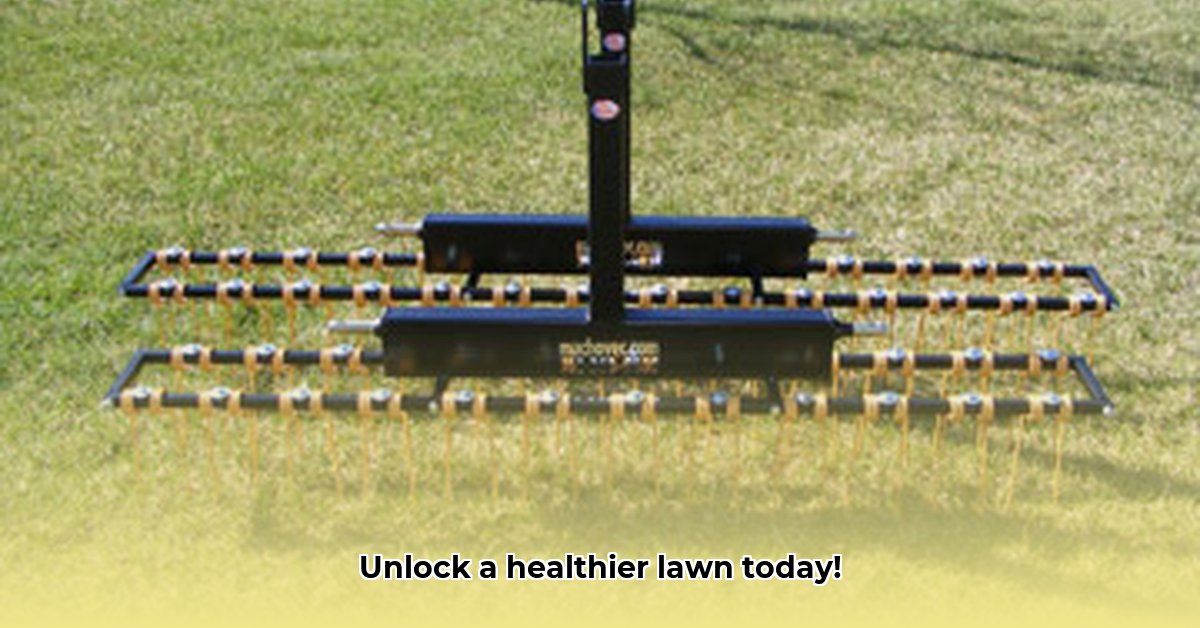
Dealing with a thick layer of thatch in your lawn? A dethatcher tractor attachment can significantly improve your lawn's health and appearance. This comprehensive guide covers everything from choosing the right attachment to proper usage and maintenance, ensuring you achieve a lush, vibrant lawn. For more in-depth information, check out this helpful resource.
Dethatcher Tractor Attachments: Revitalizing Your Lawn
Thatch, a layer of dead grass, leaves, and other organic matter between your grass blades and the soil, can stifle your lawn's growth. It prevents water and nutrients from reaching the roots, leading to weak, unhealthy grass susceptible to disease and pests. A dethatcher attachment acts like a power-wash for your lawn, removing this thatch and promoting healthy growth. But how do you choose the right one?
Understanding the Thatch Problem: Beyond an Unsightly Lawn
Thatch isn't merely an aesthetic issue; it's a significant impediment to lawn health. While a thin layer provides some insulation, a buildup of half an inch or more suffocates the grass. This results in weakened grass, increased weed growth, and a less vibrant lawn overall. A dethatcher attachment helps restore your lawn's vitality by removing this suffocating layer. Isn't that a compelling reason to invest in one?
Choosing the Right Dethatcher: Optimizing for Your Needs
Selecting the appropriate dethatcher involves several considerations. First, assess your lawn's size. A larger lawn benefits from a wider working width to increase efficiency. However, wider attachments can be less maneuverable in tight areas. Next, consider the severity of the thatch. Light thatch buildup might only require a light verticutting action, while heavy thatch needs a more aggressive scarifying tool. Finally, ensure compatibility with your tractor's three-point hitch system.
Here's a breakdown of key features:
| Feature | Options | Considerations |
|---|---|---|
| Working Width | 48 inches, 60 inches, 72 inches (and beyond) | Wider is faster but reduces maneuverability. Consider your lawn's size and shape. |
| Tine Type | Verticutting (for light thatch), Scarifying (for heavy thatch), Combination | Verticutting removes thatch superficially; scarifying cuts deeper. Combinations offer flexibility. |
| Power Requirements | Varies by model; check your tractor's specs | Ensure your tractor has sufficient horsepower to avoid overloading and damage. |
Setting Up and Using Your Dethatcher: A Step-by-Step Guide
Attaching and using a dethatcher is generally straightforward, but safety is paramount. Always consult your tractor and dethatcher manuals for specific instructions.
- Attachment: Carefully align the dethatcher with your tractor's three-point hitch, securing it using all pins and locking mechanisms. Double-check everything before starting.
- Depth Adjustment: Start with a shallow setting and gradually increase it as needed. Overly aggressive dethatching can damage your lawn.
- Operation: Engage your tractor's PTO (Power Take-Off). Drive slowly and steadily (3-4 mph is recommended), overlapping passes to ensure even coverage.
- Post-Dethatching Cleanup: Rake up and remove the detached thatch to prevent smothering your grass. Light watering afterward helps with recovery.
Maintaining Your Dethatcher: Ensuring Longevity and Safety
Regular maintenance is crucial for extending the lifespan and ensuring the safe operation of your dethatcher:
- Inspection: After each use, inspect tines for damage or wear. Bent or broken tines can be dangerous and reduce effectiveness.
- Lubrication: Lubricate moving parts according to the manufacturer's recommendations.
- Safety: Always wear safety glasses and protective clothing when operating the dethatcher. Keep children and pets away.
Did you know that regular maintenance can increase your dethatcher's lifespan by up to 25%? This translates to significant cost savings over time.
Weighing the Pros and Cons: Is a Dethatcher Right for You?
Pros:
- Efficiency: Covers large areas quickly.
- Effectiveness: Effectively removes thatch, promoting healthier grass.
- Versatility: Some models offer interchangeable tines for various thatch conditions.
Cons:
- Initial Cost: A substantial upfront investment.
- Maintenance: Requires regular maintenance and inspections.
- Tractor Required: Requires a tractor for operation.
Ultimately, the decision depends on your individual needs. However, for those serious about lawn care, a dethatcher attachment delivers a significant return on investment.
Key Takeaways:
- Dethatching significantly improves lawn health and appearance.
- Choosing the right attachment depends on lawn size, thatch density, and tractor compatibility.
- Proper setup, operation, and maintenance are essential for optimal results and safety.
Dr. Emily Carter, PhD, Horticulturalist at the University of GreenThumb, states, “A dethatcher is a powerful tool for achieving a healthy lawn. However, selecting the right attachment and understanding its proper usage is critical for success.” Investing in a dethatcher can provide a substantial payoff.